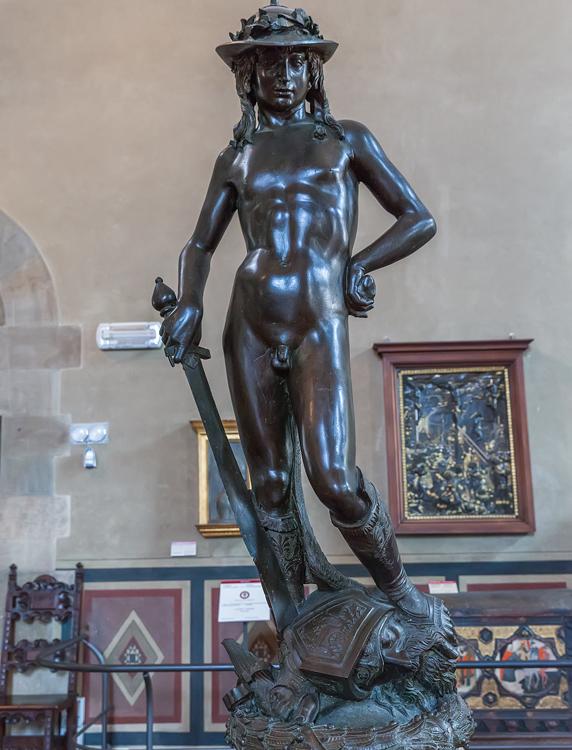The ‘Other’ David
ITA:

Use player to listen to Italian version
The David that gets all the attention in Florence is of course the one by Michelangelo, held in the Accademia Gallery. But there’s another David worth admiring in the city, a bronze sculpture by another Renaissance master, Donatello, now kept in the Bargello Museum.
Donatello’s David is the artist’s landmark work, and one of the greatest sculptural works of the Renaissance. It is the first nude sculpture in more than a thousand years; in the Middle Ages, nudity was rare, used mainly in depictions of Adam and Eve. On the other hand, in the classical world, nude statues representing gods, heroes, or athletes were common. The rediscovery of Greco-Roman culture in the Renaissance made nudes popular again, and, in his David, Donatello used the idealized proportions of Greek athletic figures. David is depicted after having defeated Goliath, entirely nude except for a shepherd’s hat with laurel leaves and boots, with one foot on top of Goliath’s severed head. He looks intent and proud, his body tense yet with an overall softness.
Around 1430, Cosimo de' Medici, the first of the Medici dynasty and the major art patron of his era, commissioned the David to Donatello for the court of his Palazzo Medici. It is now on view in the 'Donatello & 15th-Century Sculpture Room' inside the Bargello Museum. Here, you’ll also be able to see an earlier marble David by Donatello, which, with its realism, was already signaling the end of Gothic tradition; and the famous Marzocco, the lion with a paw on Florence’s emblem, which for a long time was displayed in front of Palazzo Vecchio, now replaced with a copy.
Il David che riceve tutta l'attenzione a Firenze è ovviamente quello di Michelangelo, esposto nella Galleria dell'Accademia. Ma c'è un altro David che vale la pena di ammirare in città, un bronzo opera di un altro maestro del Rinascimento, Donatello, ora custodito nel Museo del Bargello.
Il David è l'opera più importante di Donatello e una delle più grandi sculture del Rinascimento. Fu il primo nudo dopo più di mille anni; nel Medioevo, i nudi erano rari, usati per lo più nelle raffigurazioni di Adamo ed Eva. Al contrario, nel mondo classico, statue raffiguranti divinità, eroi o atleti nudi erano comuni. La riscoperta della cultura greco-romana nel Rinascimento rese nuovamente popolari i nudi e, nel suo David, Donatello usò le proporzioni idealizzate delle figure atletiche greche. David è raffigurato dopo aver sconfitto Golia, completamente nudo tranne che per un cappello da pastore con foglie di alloro e gli stivali, con un piede sulla testa mozzata di Golia. Appare assorto e fiero, il suo corpo teso ma con una morbidezza complessiva.
Intorno al 1430, Cosimo de' Medici, il primo membro della dinastia dei Medici e il principale mecenate della sua epoca, commissionò il David a Donatello per la corte di Palazzo Medici. Ora è visibile nella Sala di Donatello e delle Sculture del XV° secolo all'interno del Museo del Bargello. Qui, si può anche ammirare un suo precedente David, in marmo, che, con il suo realismo, aveva già segnalato la fine della tradizione gotica; e il famoso Marzocco, il leone con una zampa sullo stemma di Firenze, che per lungo tempo è stato esposto davanti a Palazzo Vecchio, ora sostituito da una copia.











